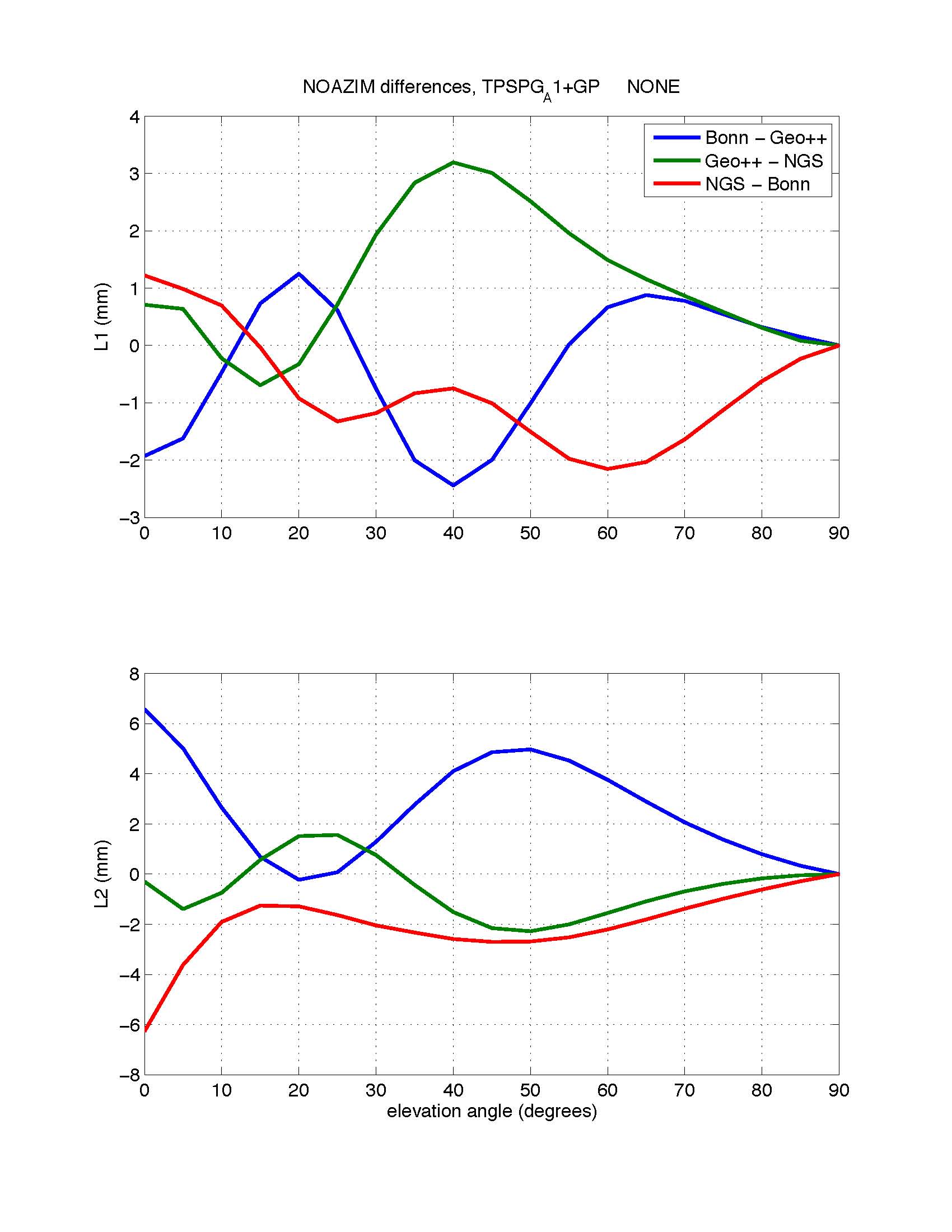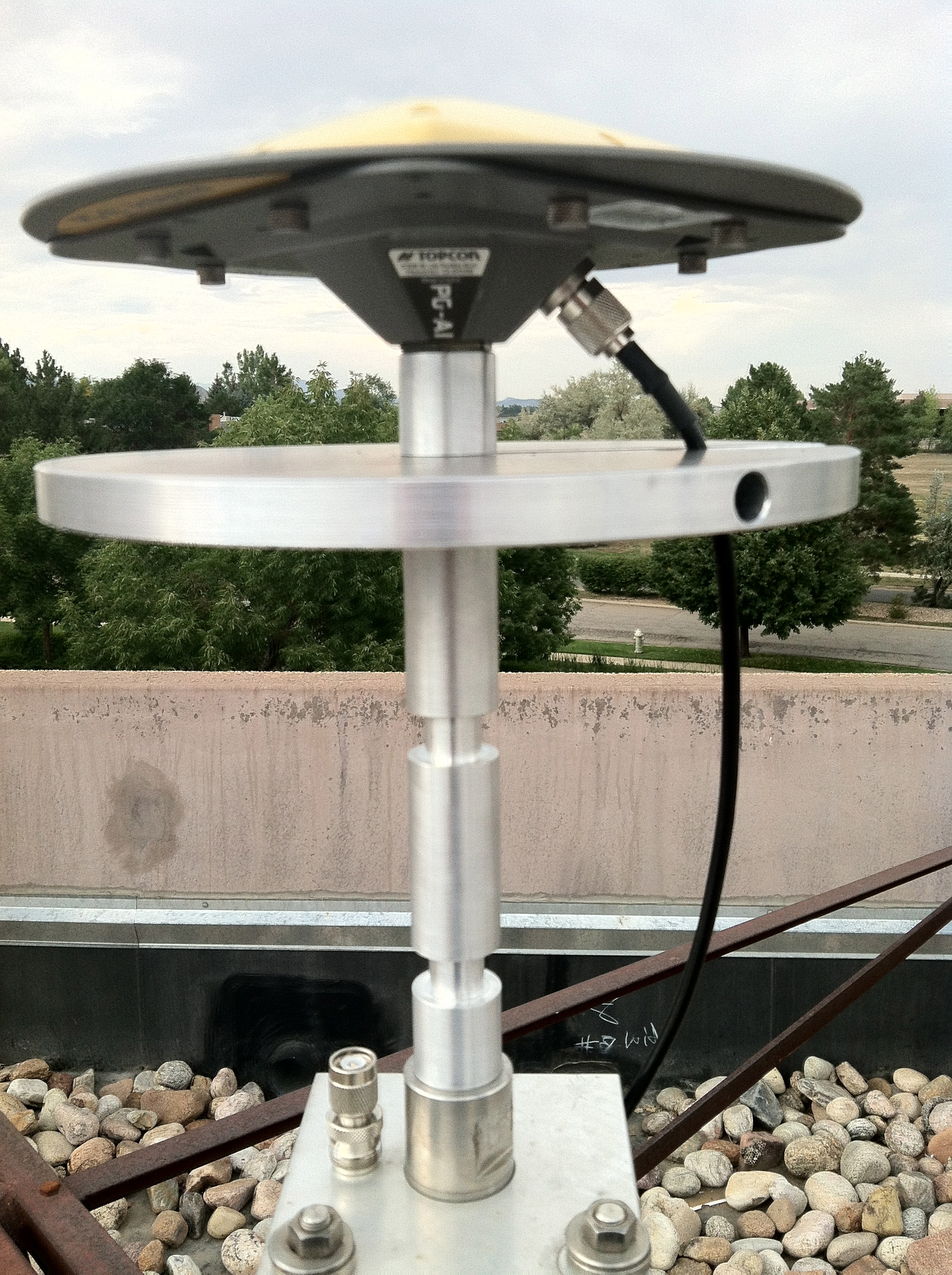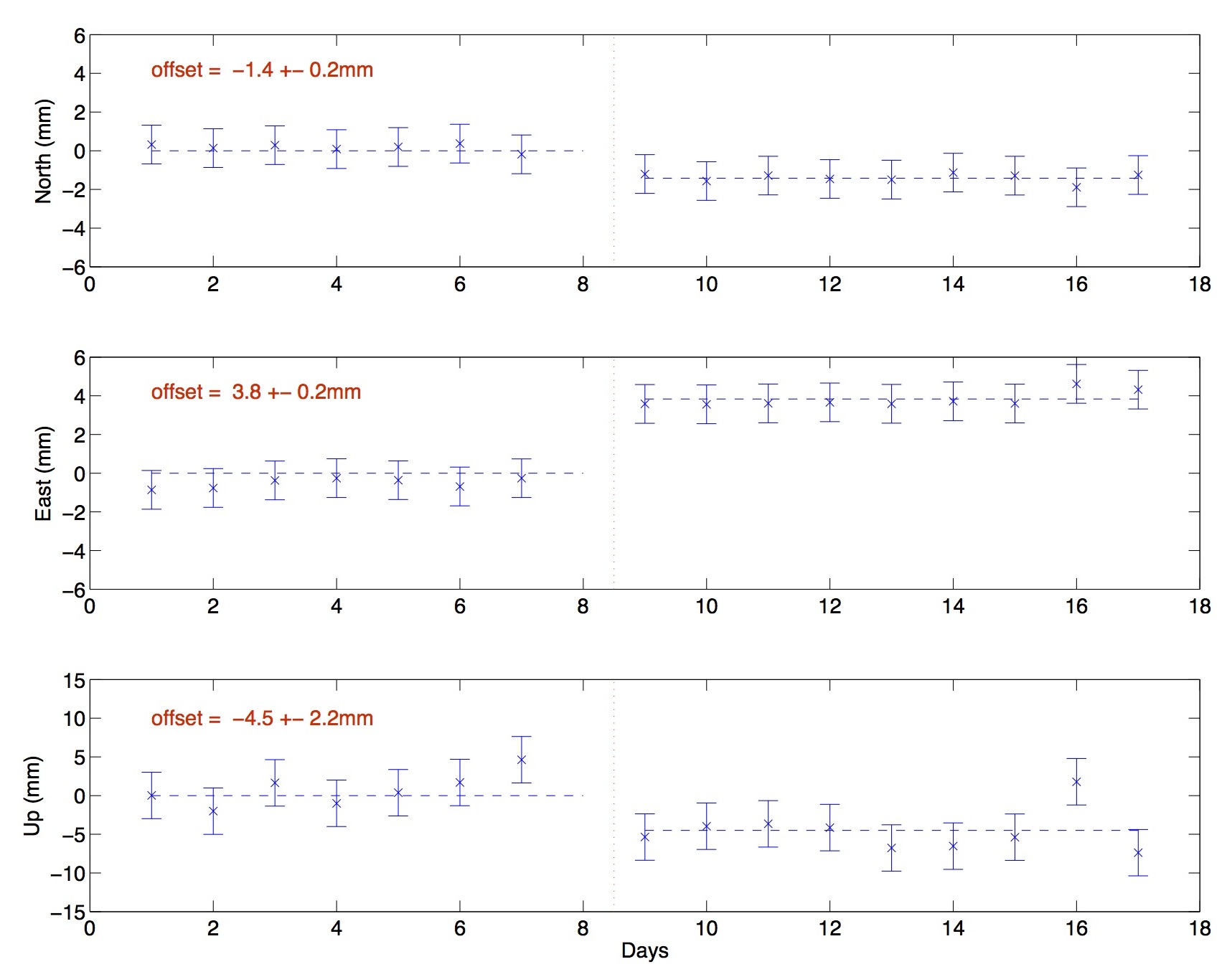GNSS Antenna Sensitivity to Site Dependent Error Sources
Background
Topcon TPSPG_A1+GP Campaign Height Measurement Bias
Problems were reported by Bob King, Adrian Borsa and other investigators regarding height estimate biases introduced when using Topcon TPSPG_A1+GP type antenna for campaign style GPS measurements. In response to these reports, UNAVCO staff conducted two short GPS campaigns at our facility to verify that height biases are introduced when using TPSPG_A1+GP type antenna. Comparisons of position estimates obtained from a Trimble TRM59800.00 choke ring and the TPSPG_A1+GP showed significant differences in the vertical component. Two campaigns were conducted using different mounting apparatus. Both campaign measurements showed vertical position offsets exceeding 10mm between antenna types. Different antenna calibration products were applied during processing, which changed the magnitude of the bias but did not effectively remove the bias. These test campaign results provoked some questions about the effect of site dependent error sources on GNSS position estimate accuracy.
What site dependent error sources contribute to position estimate differences between antenna types?
Can we develop a simple method to determine which antenna types are least sensitive to site dependent error sources?
Upon further inquiry, Andria Bilich of the NGS Geosciences Research Division found discrepancies in the TPSPG_A1+GP Phase Center Variation (PCV) calibration estimates produced by the NGS, Geo++ and Bonn. After shifting the calibration estimates to a common Phase Center Offset and differencing, she found that the elevation only patterns (NOAZIM) differ by up to 6mm (Figure 1). None of the calibrations between the facilities agree to within the 1-2mm level desired by the Antenna Working Group. When Geo++ tried recalibrating the same TPSPG_A1+GP antenna two years later, both the original and secondary calibration agreed very well. This consistency over time implies that the TPSPG_A1+GP phase center had not degraded over time and was not the cause of the disagreement between facilities. Dr. Andria Bilich suggested that the TPSPG_A1+GP type antenna might simply be more sensitive to changes in the near-field multipath environment than other antenna types. For most antenna types, the calibration products from each facility agree fairly well. Slight differences in the near-field multipath environment during the calibration procedures conducted at the NGS, Bonn and Geo++ facilities could explain the discrepancies found between each of their independent calibration products for the TPSPG_A1+GP type antenna.

Figure 1. Comparison of the NOAZIM PCVs from Bonn, Geo++ and NGS. The L1 (top) and L2 (bottom) patterns differ by up to 6mm. (Provided to UNAVCO by Dr. Andria Bilich of the NGS Geosciences Research Division)
Site Dependent Errors
Station dependent errors, which consist primarily of multipath and antenna effects, have significant influence over GNSS applications. Presently, multipath error is a major limiting factor for increasing the accuracy of GNSS positioning, especially in the vertical component. It can be useful to separate station dependent errors (SDE) into three general components. First is the error contribution from antenna phase center variations (PCV). Second, is the error contribution from far-field multipath (FFMP). And third, is the error contributed by near-field multipath (NFMP).
SDE = PCV + FFMP + NFMP
Separation of the station dependent errors as shown in the equation above can be beneficial when implementing error mitigation strategies. Each station dependent error component has independent characteristics that require unique error mitigation strategies.
Phase Center Variations
For a typical GNSS antenna the electrical phase center is not a fixed point as in the case of the idealized point antenna often shown in textbooks. The actual point where the phase is received at the antenna can depend on the frequency and direction of the received signal and other factors. To increase the accuracy of positions derived from GNSS phase measurements, facilities such as Bonn, Geo++ and the NGS measure the phase delay/advance over a grid of elevations and azimuths for each antenna type. They use those values to create a map of phase offsets. The map can then be applied while processing GNSS data to yield more accurate range measurements and thereby increase the accuracy of the final position solution.
Most geodetic quality antenna types have been calibrated at one or more of the above mentioned facilities and correction values are publicly available in the ANTEX format. In most cases, site dependent error from PCV’s can be well mitigated by accounting for model-specific variations with the application of the appropriate antenna calibration. However, for some antenna configurations calibration at a facility is not possible. Older monument designs commonly implemented an integrated dome for the purpose of protecting the antenna from the elements. Accurate antenna calibration for these sites cannot be adequately performed at a calibration facility, as the integrated dome cannot be included during the calibration procedure.
Far-Field Multipath
Multipath is defined as a signal that arrives at the antenna from the satellite by any path other than a direct path. The reflected signal can interfere both constructively and destructively with the direct signal. Here we will define Far-field multipath as signal reflections from objects located more than a few wavelengths from the antenna. When a given satellite transits the sky the interference caused by any reflected signal will oscillate between constructive and destructive phases. The period of this oscillation depends on the distance separating the reflector and the antenna. The period of the oscillations increases as separation distance between the antenna and the reflector decreases. To help mitigate the effects of far-field multipath, the reflected signal can be attenuated at the antenna by suppressing left-hand polarized signals, by using an antenna with a ground plane design, and by covering reflective surfaces near the antenna with L-band absorbent material.
For static applications where only one position estimate per day is needed, the high frequency oscillations in phase data from far-field multipath tend to average over a 24-hour period and generally do not bias a 24-hour derived position estimate. For kinematic or real-time applications far-field can have a much more significant impact on accuracy and repeatability.
Near-Field Multipath
Objects located near a GNSS antenna can cause near-field multipath. The GNSS signals are subject to signal diffraction, reflection and to more complex effects such as imaging and electromagnetic interaction. The amplitude of near-field multipath can be affected by antenna type, monument design, mount type, and weather conditions. Nearly any change to the near-field environment in the immediate vicinity of an antenna can change the reception characteristics of a given antenna. Simple analytical models using a single horizontal reflector can be used to compute theoretical phase offset values. However, in real-life applications the near-field environment is often much more complex than a single horizontal reflector. Model results for sites where the antenna’s height above a reflector is less than a few decimeters show that multipath has a very low frequency dependence with respect to satellite elevation angles. For static positioning applications, averaging over long time periods will not eliminate biases caused by near-field multipath.
Near-field multipath is an error source that is difficult to account for when processing GNSS data. Significant work has been devoted to developing in-situ antenna calibration methods for determining near-field errors. Determination of these errors has proven difficult and expensive. One only has to imagine the daunting task of managing individual calibrations for the 1000’s of high-accuracy GNSS reference sites around the world to realize the impracticality of in-situ calibrations. So, the majority of geodetic studies conducted by researchers, using permanent or campaign GNSS data for sub-centimeter positioning, typically only account for PCV’s during processing. Therefore, error contributions from near-field multipath add significantly to the position error. Especially when using the ionosphere free combination of the L1 and L2 frequencies.
Experiment Motivation
Mixing antenna types between campaign observations increases the likelihood of introducing significant station-dependent error into position estimates (both in relative and absolute positioning). To reduce the effect that these errors have on high-precision surveys, measurements at a given monument should be conducted with the same antenna and monument type for the duration of an experiment. However, the same equipment used to conduct prior observations can be damaged, become obsolete, or simply be unavailable for future observations.
Some antenna types are less sensitive to near-field multipath and in-situ calibrations are expensive and impractical. If we can determine which antennas are most sensitive to site-specific errors, then we can choose to exclude those antenna types from future experiments and reduce site dependent error.
Experiment Description
The following experiment has been developed to test GNSS antennas for their sensitivity to near-field multipath errors. To verify that near-field multipath can impact postion estimate accuracy, we developed a new antenna mount where the near-field environment could be altered without moving the antenna (Figure 2).

Figure 2. The antenna testing mount with TPSPG_A1+GP type antenna in place (looking north). The testing mount comsists of an aluminum standoff with three evenly spaced notches that allow for a aluminum disk to be precisely fixed at different heights below the antenna. The disk can be moved without displacing the antenna.
For the following tabulted results we used only the two uppermost notches on our test standoff. Approximately a week of observations were collected with the plate in the uppermost position. After a week, the plate was moved from the uppermost notch to the middle notch and an additional week of observations were collected. For each tested antenna type, the antenna was not physically displaced during the experiment. For the duration of the experiment the same reference antenna was collocated with the test antenna to create a short baseline for post-processing.
After the data were collected, the GAMIT/GLOBK software package was used for post-processing and analysis. A small regional network of 7 sites (5 regional sites + 2 test sites) were processed together. A priori coordinates and velocities (ITRF2008) for the 5 regional sites were used to establish a stable frame of reference. Estimated coordinates for the test antenna and the reference antenna were then differenced to determine daily baseline estimates in a NEU coordinate system.
Experiment Equipment List:
- Test antenna + Trimble NetR8 receiver
- Reference antenna (TRM59800.00) + Trimble NetR9 receiver
- Aluminum standoff with movable disk.
Results
Weighted least squares was used to estimate the offset that occurred in each component after the plate was moved. The resulting offset estimates for each tested antenna type are shown below.
| Antenna Type | North | East | Up | Figures |
| SEPCHOKE | 0.3 +− 0.2 mm | 0.2 +− 0.2 mm | -2.7 +− 2.1 mm | Figure |
| TPSCR.G3 | 0.4 +− 0.1 mm | 0.0 +− 0.1 mm | 2.1 +− 1.3 mm | Figure |
| TPSPG_A1+GP | -1.4 +− 0.2 mm | 3.8 +− 0.2 mm | -4.5 +− 2.2 mm | Figure |
| TRM41249 | -0.3 +− 0.2 mm | -0.3 +− 0.2 mm | 0.3 +− 2.2 mm | Figure |
| TRM59800 | -0.2 +− 0.4 mm | -0.5 +− 0.4 mm | -0.2 +− 3.4 mm | Figure |
| TRM59900 | -0.2 +− 0.4 mm | -0.4 +− 0.4 mm | -0.2 +− 3.3 mm | Figure |
| TRM57971 | 0.5 +− 0.4 mm | 0.4 +− 0.4 mm | -2.9 +− 3.2 mm | Figure |

Figure 3. Daily baseline estimates (north,east,up) between reference antenna (TRM59800.00) and test antenna (TPSPG_A1+GP). The mean was subtracted from each component. The dashed blue line shows the least squares fit. The red text displays the calculated offset and uncertainty for each component.
Conclusion
We have shown that changing the near-field environment beneath a GNSS antenna can significantly affect the site dependent errors for certain antenna types. Increased noise in the vertical component of the time series limits the resolution of our offset estimates. This test shows that an antenna’s sensitivity to near-field electromagnetic changes can be measured with sub-millimeter precision in the horizontal components. Longer observation periods could reduce the uncertainty of each offset estimate.
Testing additional antenna types with this method may help to determine which types are best suited for geodetic applications. UNAVCO will continue testing other antenna types and post the results to the Knowledge Base.
Questions or Comments? Please contact Henry Berglund; email: berglund @ unavco.org
)